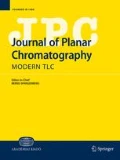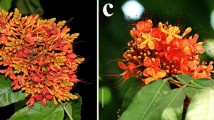Abstract
Euphorbia hirta and Euphorbia thymifolia are plants with the same regional name “Dudheli” in Gujarat region, India. The present study has been conducted with comparative analysis of two plants, E. hirta and E. thymifolia, for total flavonoid content, total phenolic content, and quantification of biomarkers (rutin, gallic acid, and quercetin) by using high-performance thin-layer chromatography (HPTLC). Total phenolic contents (TPC) and total flavonoid contents (TFC) were evaluated by Folin‒Ciocalteu method and aluminum chloride colorimetric method, respectively. An improved HPTLC method was developed and validated for the simultaneous estimation of rutin, quercetin, and gallic acid. TPC was found more in the methanolic extract of E. hirta, and TFC was found almost the same in ethyl acetate extracts of both plants. Both plants showed the presence of rutin, quercetin, and gallic acid. The results of the HPTLC study provided a valuable bioactive marker content comparison between two species of the Euphorbiaceae family.
Graphic abstract






Similar content being viewed by others
Availability of data and material
The datasets used and/or analyzed during the current study are available from the corresponding author on reasonable request.
References
Anonymous (2008a) Ayurvedic Pharmacopoeia of India, Part 1. Ministry of Health and Family Welfare, Department of AYUSH, New Delhi, Government of India, vol 5, pp 36–38
Anonymous (2008b) Ayurvedic Pharmacopoeia of India, Part 1. Ministry of Health and Family Welfare, Department of AYUSH, New Delhi, Government of India, vol 6, p 62
Anand V, Kausar J, Muthumani D, Hedina A, Sivasamy R (2016) Review of pharmacological and phytochemical activities of Euphorbia hirta Linn. Pharmacogn J 8(4):310–313. https://doi.org/10.5530/pj.2016.4.2
Oparaocha ET, Okorie C (2009) In vivo evaluation of the antimalarial activity of three medicinal plants used in South Eastern Nigeria. J Herbs Spices Med Plants 15(1):121–128. https://doi.org/10.1080/10496470902797914
Sashini DP, Uthpala AJ, Chanika DJ (2018) Potential use of Euphorbia hirta for dengue: a systematic review of scientific evidence. J Trop Med, Article ID: 2048530. https://doi.org/10.1155/2018/2048530
Ogueke CC, Ogbulie JN, Okoli IC, Anyanwu BN (2007) Antibacterial activities and toxicological potentials of crude ethanolic extracts of Euphorbia hirta. J Am Sci 3(3):11–16
Johnson PB, Abdurahman EM, Tiam EA, Abdu-Aguye I, Hussaini IM (1999) Euphorbia hirta leaf extracts increase urine output and electrolytes in rats. J Ethnopharmacol 65(1):63–69. https://doi.org/10.1016/s0378-8741(98)00143-3
Subramanian SP, Bhuwaneshwari S, Prasath GS (2011) Anti-diabetic and anti-oxidant potentials of Euphorbia hirta leaves extract studied in streptozotocin-induced experimental diabetes in rats. Asian Pac J Trop Med 5:386–390. https://doi.org/10.4149/gpb_2011_03_278
Rastogi R, Mehrotra B (2002) Compendium of Indian medicinal plants, vol 4. Central Drug Res Inst, Lucknow, pp 110–111
Kirtikar KR, Basu BD (1975) Indian medicinal plants, 2nd edn. Bishen Singh Mahendra Pal Singh, Dehradun, p 2199
Lin CC, Cheng HY, Yang CM, Lin TC (2002) Antioxidant and antiviral activities of Euphorbia thymifolia L. J Biomed Sci 9(6):656–664. https://doi.org/10.1159/000067281
Mali PY, Panchal SS (2013) A review on phytopharmacological potentials of Euphorbia thymifolia L. Anc Sci Life 32(3):165–172. https://doi.org/10.4103/0257-7941.123001
Nadkarni KM, Nadkarni AK (2007) Indian MateriaMedica, vol 1. Popular Prakashan, Bombay, p 529
Basma AA, Zakaria Z, Latha LY, Sasidharan S (2011) Antioxidant activity and phytochemical screening of the methanol extracts of Euphorbia hirta L. Asian Pac J Trop Med 4:386–390. https://doi.org/10.1016/S1995-7645(11)60109-0
Mustafa RA, Abdul HA, Mohamed S, Bakar FA (2010) Total phenolic compounds, flavonoids, and radical scavenging activity of 21 selected tropical plants. J Food Sci 75:28–35. https://doi.org/10.1111/j.1750-3841.2009.01401.x
Wu Y, Qu W, Geng D, Liang JY, Luo YL (2012) Phenols and flavonoids from the aerial part of Euphorbia hirta. Chin J Nat Med 10(1):40–42. https://doi.org/10.1016/S1875-5364(12)60009-0
Kumar A, Intekhab J (2013) Phytochemical studies on Euphorbia hypericifolia. Natura Proda Medica 5(1):2–5
Mukherjee D, Kuma NS, Khatua T, Mukherjee PK (2010) Rapid validated HPTLC method for estimation of betulinic acid in Nelumbonucifera (Nymphaeaceae) rhizome extract. Phytochem Anal 21:556–560. https://doi.org/10.1002/pca.1232
Ciesla L, Hajnos M, Staszek D, Wojtal L, Kowalska T, Hajnos MWV (2010) Validated Binary high-performance thin-layer chromatographic fingerprints of polyphenolics for distinguishing different Salvia species. J Chromatogr Sci 48:421–427. https://doi.org/10.1093/chromsci/48.6.421
Ghosh P, Katiyar A (2012) Densitometric HPTLC analysis of juglone, quercetin, myricetin, rutin, caffeic acid, and gallic acid in Juglans regia L. J Planar Chromatogr 5:420–425. https://doi.org/10.1556/jpc.25.2012.5.6
Patel AA, Amin AA, Patwari AH, Shah MB (2017) Validated high performance thin layer chromatography method for simultaneous determination of quercetin and gallic acid in Leeaindica. Rev Bras Farmacogn 27(1):50–53. https://doi.org/10.1016/j.bjp.2016.05.017
Hussain J, Bassal M, Sarhan H, Mouhammad IHA (2017) Qualitative and quantitative comparison of rutin, quercetin and gallic acid concentrations in Syrian Capparisspinosa L Leaves. J Pharmacogn Phytochem 6(4):407–415
NairJ Ahamad J, Khan W, Anjum V, Mathur R (2017) Development and validation of high-performance thin-layer chromatography method for simultaneous determination of polyphenolic compounds in medicinal plants. Pharmacogn Res 9(Suppl 1):S67–S73. https://doi.org/10.4103/pr.pr_122_16
International Conference on Harmonisation, Guideline Q2 (R1) (2005) Validation of analytical procedures: text and methodology. ICH, Geneva. http://www.ich.org/LOB/media/MEDIA417.pdf
Dutta S, Ray S (2020) Comparative assessment of total phenolic content and in vitro antioxidant activities of bark and leaf methanolic extracts of Manilkarahexandra (Roxb.) Dubard. J King Saud Univ Sci 32(1):643–647. https://doi.org/10.1016/j.jksus.2018.09.015
Blainski A, CristinyGL Carlos JPM (2013) Application and analysis of the Folin–Ciocalteu method for the determination of the total phenolic content from Limonium brasiliense L. Molecules 18:6852–6865. https://doi.org/10.3390/molecules18066852
Funding
No funding was received for conducting this study.
Author information
Authors and Affiliations
Corresponding author
Ethics declarations
Conflict of interest
The authors have no conflict of interest to declare that are relevant to the content of this article.
Electronic supplementary material
Below is the link to the electronic supplementary material.
Rights and permissions
About this article
Cite this article
Vadalia, J.M., Sanandia, J. & Sheth, N. Comparative quantitative phytochemical and HPTLC analysis of two Euphorbiaceae family plants under the name Dugdhika. JPC-J Planar Chromat 33, 473–479 (2020). https://doi.org/10.1007/s00764-020-00059-4
Received:
Accepted:
Published:
Issue Date:
DOI: https://doi.org/10.1007/s00764-020-00059-4




